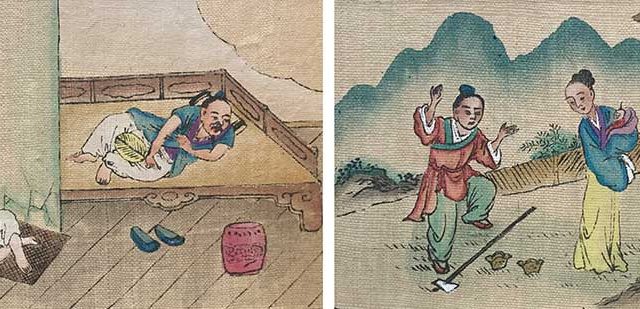As a historian, I spend most of my time thinking about the past. This can involve reading about it, writing about it, or teaching students. So it made a nice change, during a month spent working with the Victoria and Albert Museum’s Renier Collection of children’s books, to encounter a little booklet titled Five Hundred Questions Deduced from Goldsmith’s History of England: Calculated to Instruct Young Persons in the Causes, Consequences, and Particulars, of Events in English History (published in about 1816) by James Adair. The History of England Adair’s references was written by Oliver Goldsmith (1728? – 1774), an Anglo-Irish author and friend of Samuel Johnson, while James Adair may have been the pseudonym of Sir Richard Phillips (1767 – 1840), who published educational texts.

Although we’re not supposed to judge a book by its cover, on this occasion it’s justified to do so. The book contains 500 questions about British history between the Roman invasion of Britain in 43 AD and 1813, and it was obviously intended to be used with Goldsmith’s book.
Reading the questions got me thinking about the different ways history has been taught in the past. I had spent the early summer marking undergraduate exam papers, so I was intrigued to see what kind of questions were explored in the early nineteenth century. Many of the topics the book contains are things we still think about today. It also made me laugh, as some of its entries are a little strange to a modern eye.
Learning history in 1816
I expected to find a long and potentially peculiar list of questions about English history (in eighteenth-century terms, this often included Wales, Scotland and Ireland, and sometimes the British Empire). What I didn’t anticipate was encountering annotations by whoever owned the book 200 years ago. This book wasn’t just kept on a shelf: someone used it to study!
My first assumption was that the handwriting belonged to a student. For example, question 27 asks ‘How long lasted the Roman dominion in Britain, and how long the Saxon heptarchy?’ and the penciled note replies ‘Romans nearly 400 years & the Saxons 600’. This seems reasonable, if a bit brusque for a child’s schoolwork. Then again, there isn’t much space for detail, so perhaps that didn’t matter.
Then I began to reconsider. If someone could afford a copy of Goldsmith’s History of England, surely they could also afford a notebook, or some folios of paper? The handwriting also looks too small and regular to be a child’s, and some of the annotations just record page numbers, which must refer to the passage in Goldsmith where the answer was found. Most likely this was the teacher’s crib-sheet to help them find passages quickly during lessons.
In fact, there’s no reason to assume that the child or children who were taught from this booklet necessarily wrote their answers at all. As Hannah Newton argues, religious teaching usually catechised children – that is, asked them questions to consolidate their learning. Answers would also have been verbal. Whoever used this booklet might also have examined their students aloud rather than making them write answers down.
Answering the 500 questions
The questions are a wonderful mix of general knowledge that you might find in a pub quiz today; questions that would not be out of place on an undergraduate history exam; and weird and wonderful questions that tell us a lot about the way people viewed history in the early nineteenth century. Here are a few of my favourites, with the annotations, extracts from Goldsmith’s original, and my comments.
Q. 6. What motive occasioned Cæsar to invade Britain? (page 8)


Annotation: It appeared an easy conquest.
Goldsmith: Cæsar, having over-run Gaul with his victories, and willing still farther to extend his fame, determined upon the conquest of a country that seemed to promise an easy triumph [page 7].
This is basically a general-knowledge question.
Q. 394 What led to the French Revolution in 1789? (page 48)

The annotations actually stop before this question, and Goldsmith doesn’t answer it either. He couldn’t: he died in 1774, 15 years before the Revolution. The booklet’s author recommended a few other history books in his introduction, but it feels a bit like cheating to include questions about something that wasn’t in the source text the booklet was based on. Then again, this edition of the Questions was published around 1816, so the French Revolution would have been very much part of lived experience for many adults, much as the Falklands or Iraq Wars are today. Modern historians are still arguing about what caused the French Revolution, so whatever answer was given in the ‘Tutor’s Key’, advertised in the booklet’s introduction, it probably gives only one side of a very complicated debate.
And my personal favourite:
Q. 182. What were the dying feelings of the monster, Henry VIII? (page 26)

Annotation: X 173.
Goldsmith: The disorder in [Henry’s] leg was now grown extremely painful; and this, added to his monstrous corpulency … made him more furious than a chained lion… [But on being told that he was dying] His anguish and remorse were … greater than can be expressed [pages 246–47]
I love this question. Historians today try not to make value-judgements about historical figures; we try to keep our opinions out of the text. But it’s easy to see why Henry VIII is described as ‘the monster’: he’s famous for splitting from the Catholic Church so he could divorce his first wife, and had two of his wives beheaded, as well as being depicted as larger-than-life in his physical size and personal appetites. There are specialists who study the histories of the emotions and the body who would be much more cautious about assigning feelings like pain, anger and guilt than Goldsmith is here – and who would certainly offer more evidence. We might equally wonder whether Henry’s ‘dying feelings’ weren’t along the lines of ‘give me more laudanum for the pain!’
Try it yourself
I’ll leave you with a brief quiz drawn from the booklet. Answers are included below; any peculiarities in spelling, capitalisation, or grammar are faithful to the original printing.
- What woman headed the Britons against the Romans?
- Who succeeded Edward the Confessor, who opposed him, and why?
- How was William Rufus killed?
- Describe the cause and the circumstances of Becket’s death.
- What was the origin of the red and white rose, and what did they designate?
- Who was King James, and whom did he succeed?
- What was the religion of James II?
- When, and why, did the Americans publish their declaration of independence?
- How long had the house of Hanover sat on the throne in 1810?
- Under whom was the union with Scotland effected, and when?
Answers and page references for original questions
- Boudicca was the queen of the Iceni tribe and led the Britons against the Roman invasion. Question: page 7, question 2. Annotation given reads ‘Boadicea’.
- The answer to part one of the question is Harold Godwinson. Acceptable answers to part two of the question are Harald Hardrada AND one of William the Conqueror, William of Normandy, or William the First. Both Harald and William also claimed the English throne in 1066; Harald lost to Harold Godwinson’s army at the Battle of Stamford Bridge, and William won against Harold at the Battle of Hastings. Question: page 10, question 36. Annotation reads ‘Harol [sic]. William Duke Normandy who said the crown belonged to him’.
- William Rufus was shot by an arrow while out hunting. Question: page 15, question 91. Annotation reads ‘[He was?] shot by an arrow that [illegible]’.
- Thomas Becket was the Archbishop of Canterbury, and he was martyred in Canterbury Cathedral, after a fight with Henry II. The story goes that Henry, in a rage with Becket, shouted ‘Who will rid me of this turbulent priest?’ He was overheard by some knights who immediately set out to kill Becket in the hope of reward. As a result, England was excommunicated by the Pope. Question: page 17, question 105. Annotation reads ‘’81[?]’.
- The red rose was the symbol of the House of Lancaster, and the white rose was the symbol of the House of York. During the Wars of the Roses, these two powerful noble families divided England as they fought over the throne. When the Tudors eventually won the war, they created the Tudor rose, comprising both the red and the white flower, to signal the peace the new unity they intended to bring to the kingdom. Question: page 27, question 197. Annotation reads ‘130’.
- King James I of England succeeded Queen Elizabeth I in 1603. He was already King James I of Scotland at the time he inherited the English throne. Question: page 31, question 238. Annotation reads ‘Son of Mary. Queen of Scots. He succeeded Elizabeth’.
- James II was Catholic. He was removed from the throne in 1688 because the Protestant elite didn’t want him to return the country to the Catholic faith. Question: page 39, question 308. Annotation: ‘Roman Catholic’ [inscribed above the page header, away from the question].
- The American Declaration of Independence was made in 1776. It signalled the creation of the United States of America as an independent nation, free from British rule. As Goldsmith died in 1774, this question implies that Adair expected his readers to use other books, or perhaps to know about it from grandparents’ stories, given that this was only forty years before the probable publication date of the booklet. Question: page 50, question 422. No annotation.
- The Hanoverian dynasty ascended the British throne in 1714, when George I succeeded Queen Anne, so by 1810 they had held the throne for 96 years. Question: page 54, question 451. No annotation.
- England and Scotland were joined in the Act of Union in 1707, during the reign of Queen Anne. Question: page 57, question 481. No annotation.



This is fascinating. Finding the annotations must have been a real treat. It’s interesting how teachers haven’t changed all that much in 200 years.
I do believe, however, that for question 6 about Elizabeth’s successor that James was James VI of Scotland, not James I of Scotland.